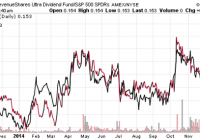Dull Industrial Earnings Put These ETFs In Focus
As previously expected the Industrial sector has come out with lukewarm results for the fourth quarter earnings season. The major players in the space, such as General Electric (NYSE: GE ) , Caterpillar Inc. (NYSE: CAT ) and 3M Company (NYSE: MMM ) , have reported lackluster results, missing either on revenues or earnings. In fact, a disappointing performance from industrial leader Caterpillar and weaker-than-expected data on durable-goods orders sparked fears about a slowdown in economic growth, leading the Dow Jones Industrial Average to plunge more than 350 points in yesterday’s trading session. Industrial Earnings in Focus General Electric Operating earnings for the reported quarter came in at 56 cents per share compared with 53 cents a share in the year-ago quarter, beating the Zacks Consensus Estimate by a penny. The company posted net earnings of 51 cents per share, up 61% year over year. Total revenue for the quarter increased 4% year over year to $42 billion but fell short of the Zacks Consensus Estimate of $42.4 billion. The company’s operating profit in the Industrial segment increased 9% in the reported quarter as its businesses that sell power-generating turbines and jet engines helped offset weak sales in its oil and gas unit. However, GE Capital’s profit declined 19% year over year to $1.9 billion. The company, however, is committed to increasing its focus on industrial operations, away from finance. Caterpillar Mining and equipment behemoth Caterpillar however missed Q4 earnings estimates and also guided lower for 2015. Earnings per share declined 20% year over year to $1.35 per share, missing the estimates by 13%. Revenues declined 1% year over year to $14.2 billion in the quarter but surpassed the Zacks Consensus Estimate of $14.1 billion. The company blamed the muted mining environment and lower prices of oil and key mined commodities, particularly copper, coal and iron ore as the key factors behind the earnings miss. Moreover, the company also guided materially lower for 2015 due to continued weakness in oil prices. The company expects 2015 EPS of $4.75 on $50 billion in revenues, significantly below the current Zacks Consensus Estimate for 2015 of $6.69 in EPS on $54.6 billion in revenues Union Pacific Corporation (NYSE: UNP ) The rail transportation operator, Union Pacific , managed to beat our estimates on both fronts. Earnings per share rose 27% year over year to $1.61, beating the Zacks Consensus Estimate of $1.51, while revenues increased 9% year over year to $6.2 billion, ahead of the Zacks Consensus Estimate of $6.1 billion. 3M Company Like General Electric and Caterpillar, 3M also reported mixed financial results, beating on the earnings front but missing on revenues. Earnings per share came in at $1.81 per share, up 11.7% year over year, beating the Zacks Consensus Estimate by 2 cents a share. Net sales during the quarter were $7,719 million, up 2% year over year, but below the Zacks Consensus Estimate of $7,779 million. Market Impact Uneven earnings results from the top industrial stocks saw mixed reactions. While GE is up 5% since its announcement on January 23, Caterpillar shed 7% yesterday following its disappointing results. Meanwhile, 3M and Union Pacific closed marginally lower following their earnings. Given the uninspiring earnings results from some of the top industrial players, investors should cautiously play the industrial ETF space for the upcoming days. Below, we have highlighted three industrial ETFs having a sizeable exposure to the above stocks. Industrial Select Sector SPDR (NYSEARCA: XLI ) XLI is the most popular fund in the space with an asset base of $8.8 billion and an average daily trading volume of 9.9 million shares. The fund provides exposure to a basket of 66 stocks charging 65 basis points as fees. General Electric occupies the top spot with 9.3% allocation, while Union Pacific, 3M and Caterpillar have a combined exposure of roughly 14.2% in the fund. XLI lost 1.32% on Tuesday but is up 13.1% in the past one year and currently has a Zacks ETF Rank #3 or Hold rating. Vanguard Industrials ETF (NYSEARCA: VIS ) VIS is also quite a popular fund in the space with an asset base of more than $1.9 billion and trading with moderate volumes. VIS tracks the MSCI U.S. Investable Market Industrials 25/50 Index to provide exposure to 352 industrial stocks. The four stocks have a combined exposure of roughly 21%. VIS lost 1.2% in yesterday’s session and currently has a Zacks ETF Rank #3 or Hold rating. iShares U.S. Industrials ETF (NYSEARCA: IYJ ) IYJ tracks the Dow Jones U.S. Industrials Index to provide exposure to U.S. companies that produce goods used in construction and manufacturing. General Electric, Union Pacific, 3M and Caterpillar are among the top 10 holdings with a combined exposure of roughly 19.4%. The fund manages an asset base of $ 861.5 million and is slightly expensive with 43 basis points as fees. IYF currently has a Zacks ETF Rank #3 or Hold rating.
